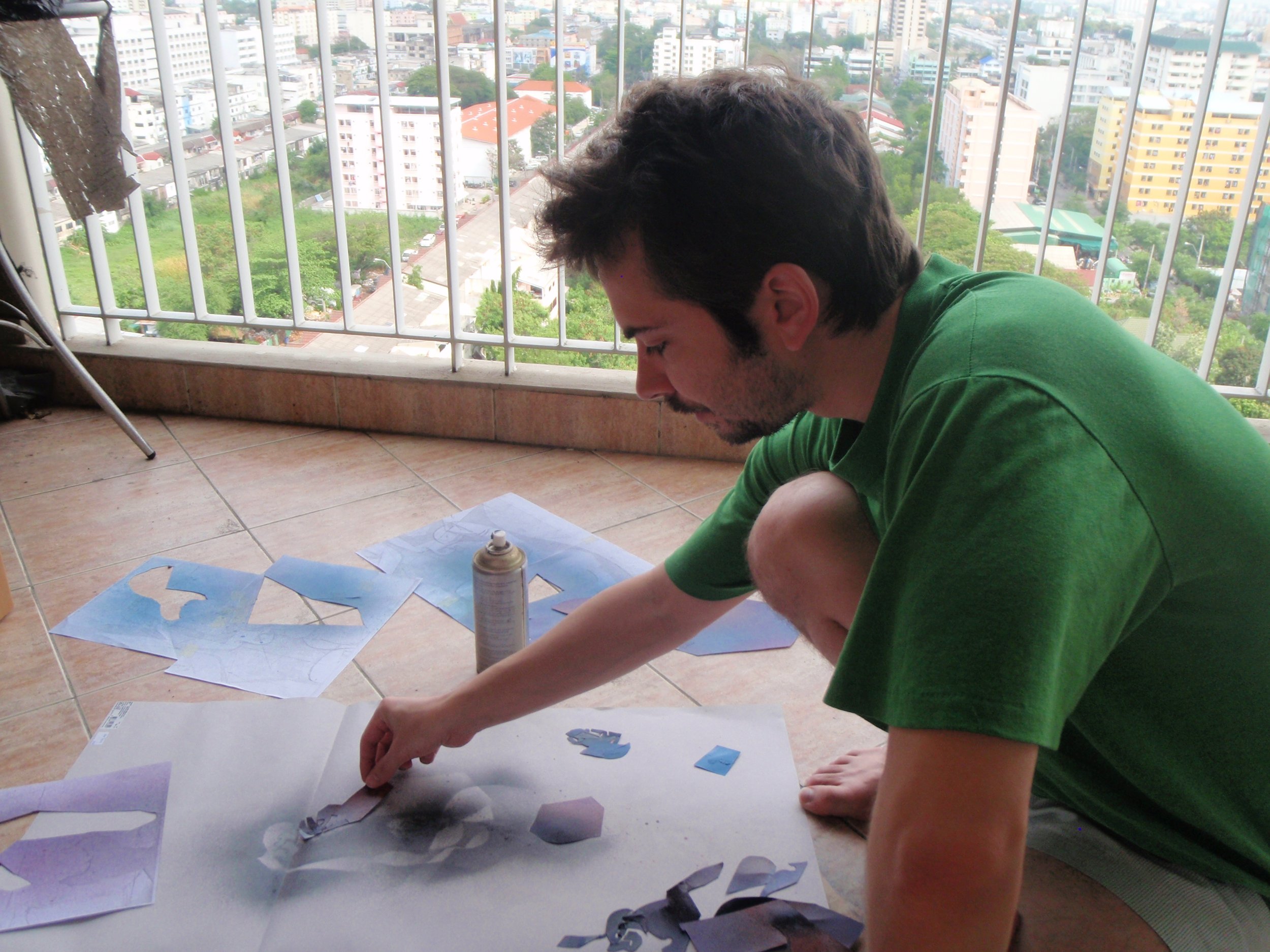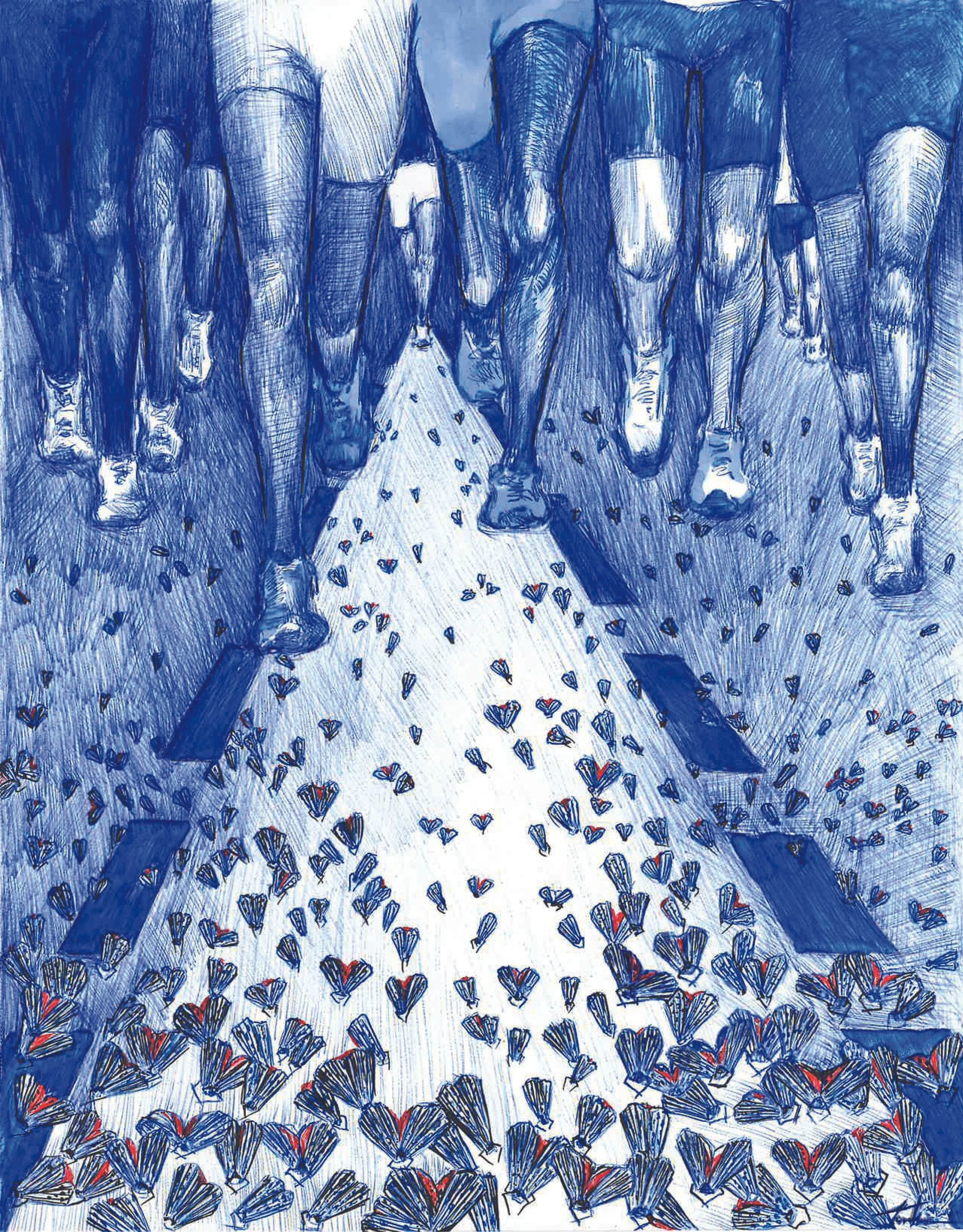10 Questions with Daniel Sewell
Daniel Shane Sewell (b. 1978) is a visual artist who lives and works in Pattaya, Thailand. He collaborates with his son, Tristan Athit Sewell (b. 2013), on a wide range of creative projects. Together, they took part in the Urban in Progress exhibition at the Bangkok Art and Cultural Centre (BACC), Bangkok (Thailand) in 2021, and to the TARS Gallery Pavilion and the Gallery VER Pavilion/Bangkok Underground Film Festival for the 2018 Bangkok Biennale, Bangkok.
Daniel and Tristan Sewell - Portrait
ARTIST STATEMENT
Daniel Shane Sewell is a visual artist who, alongside highly original video and sound work, produces lecture content dedicated to traditional techniques and methods from history.
INTERVIEW
Could you share a bit about your background in art and how you came to be an artist?
All around me was art. All around me was music. Creativity was held in high regard. We were encouraged and supported to engage with the arts and to do so with purpose. I want to learn from the best and not shy away from harder things. Set a foundation and go up. But there was never any snootiness around learning rules – it's about how to handle a rule and how to open up new levels of creativity. In my work, I'm collecting a lot of rules, techniques, and maneuvers and cataloging them encyclopedically and in sequences. What I add is my handle on them. I think differently than most people about what inspiration is. In my work, what is important is the connection – especially through technique – to a timeline.
© Daniel Sewell
You collaborate with your son on various projects. How does this collaboration influence your artistic process and the outcome of your work?
My son and I, Tristan, 10, make video-log style work that begins with simple aesthetic questions (sometimes as a lesson between us). What follows are Socratic-form exchanges on issues in art. What is aesthetics? What is beauty? What is sacred? What is profane? As father and son figures, the work is charged with social connotations. Our work has stacked layers, but still through it, both the content and the method can be read – it can inform and can teach.
You are currently living in Thailand. Do you find that this has any influence on your work or your approach to art?
It is a very peaceful place and one that has influenced my sense of time. My art uses timelines, history and near-history so much – I find where I live, which is also right on the water, fosters an appreciation of time and one's place in it, differently. I live here for metaphysical reasons.
Can you describe the range of mediums you work with? Do you have a favorite medium or technique?
Common to all our work is drawing. The type of mark and the line quality of the mark are important. I myself find endless joy in spray paint as a drawing medium. As a kid, I used virtual spray paint on the old Macs before using the real can, which is a 'whole-body' drawing. And both teach the importance of masks/stencils. I like tools with a traceable timeline – a tool that has evolved in front of you during your lifetime. A tool whose evolution has streamlined the use, the utility – the labor – of the tool. With tools or media like that, I engage completely and try everything, knowing that it needs pressure on it to continue evolving.
I also like media that can be moved around easily and collaged, assembled. If drawing or spraying in layers, bringing those layers into AR is collaging. Tristan and I predominantly work this way when drawing digitally together.
How do you balance your exploration of traditional techniques with your experimentation in video and sound work? Do you find one informs the other?
That's the very question – because there's such an extreme difference between the look of our work and its actual content. Normally, formal is the word. Virtuoso. But, in our timeline now, we realize that painting is nearly dead, and paper will soon follow. Some traditional techniques are nearly extinct and may die off when their medium finally goes. The informing part starts when the technique does not disclose itself so easily. The video's purpose is documentation. The video is an impartial voyeur. When I'm exploring a traditional technique – which is always unrehearsed and unstudied, I'm documenting the whole process. The output is a series of performances. Exploring, finding, lecturing, conjecturing, writing, and giving lessons are all part of a sequence. I have only the intention to reduce the technique to its most basic parts. And these techniques are right on the cusp of disappearing. This is a concept of technique as a timeline, as a collective lineage behind every stroke of the brush – but a lineage that is dying away at an accelerated pace. This is why Tristan and I draw, as father and son, in the sand, naked ladies on the beaches in Pattaya, Thailand.
What themes or concepts do you often explore in your visual art and multimedia projects?
Themes are important because they determine the format of the work. I usually think of larger concepts after the work is done. Then, I can produce the work serially. The game format is especially interesting when played between father and son. Racing is ranked pretty high because the more you do it, the better you get. We use Croquis a lot, with time constraints, and it pairs well with time-lapse video.
Could you walk us through your creative process when starting a new project? How do you generate ideas and translate them into tangible artworks or videos?
I think like a sculptor. My mind can visualize something like a holo-deck – that is what AR is. AR is first a medium of sculpture, and it shares methods based on collage. I'm always working – always making something. I'm always looking at ways to build something. I keep a work ethic. I look through older work a lot, reframe it, re-do it, and keep working on it. I like to keep ideas for many years, keep refining them, and get to their core. It's when the core resonates with whatever work I have on top of it – that's when the work peaks, when I can plan out a series of different media outcomes, and when I'm at a creative height. And because I'm always working, I'm always well-practiced. I like to make a series and another series and another, etc. I see Tristan doing something similar. That's when we'll bring each other in – I see myself in him, which adds a dimension to how we work together. It adds new meaning to the famous saying that every painting is a self-portrait.
Where do you find inspiration for your work? Are there any particular artists, movements, or experiences that have influenced your artistic vision?
Being an interdisciplinary artist, I often pull inspiration from other creative fields unwillingly. Music and music history overflow their resources. If I find a musician or composer doing something totally unique with tones, scales, or instruments, I can posit the parallel of that in visual or sculptural terms. Easy-peasy. Often I reflect on my own timeline, and can see where I could've had better guidance as a student artist. The part of my oeuvre that is pedagogical – I make these works because this is what I wish I could've read as a young artist. A big influence is that inner voice, and I keep a dialogue with my younger self.
Can you discuss any current or upcoming projects you're excited about? What can audiences expect from these endeavors?
Yes, I myself have an academic project on Picasso's Anatomy. I have a number of lectures and reconstructions of anatomy, as Picasso used them, that serve as footnotes to a more general encyclopedia of aesthetic ideals.
Looking ahead, what are your aspirations or goals as an artist? Are there any new directions or collaborations you hope to pursue in the future?
I'm converting a lot of work for immersion – especially immersion education. I see the Immersion market needing an educational component. Public art education is mostly appreciation. I see opportunity in the future for true art education happening in other spaces.
Artist’s Talk
Al-Tiba9 Interviews is a promotional platform for artists to articulate their vision and engage them with our diverse readership through a published art dialogue. The artists are interviewed by Mohamed Benhadj, the founder & curator of Al-Tiba9, to highlight their artistic careers and introduce them to the international contemporary art scene across our vast network of museums, galleries, art professionals, art dealers, collectors, and art lovers across the globe.
















